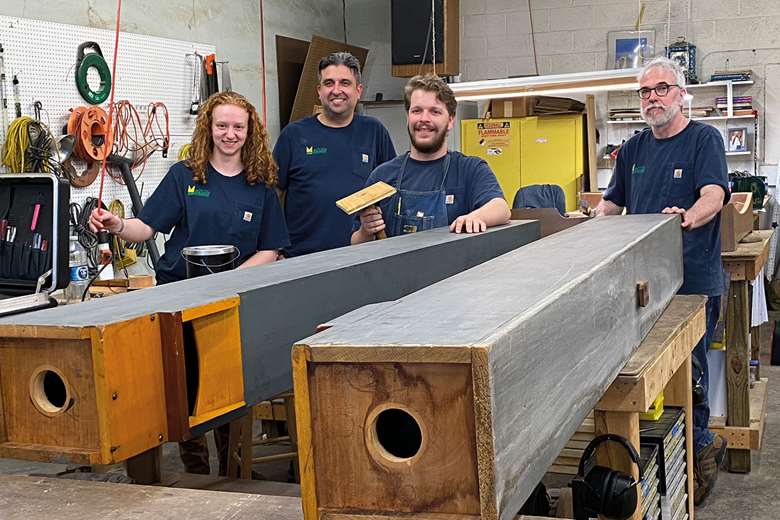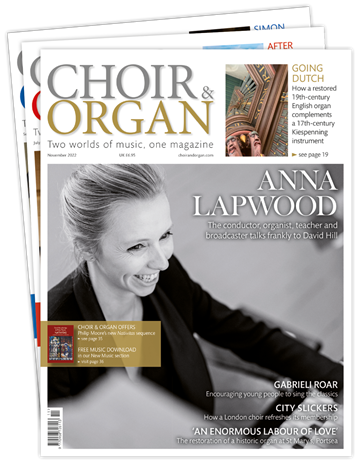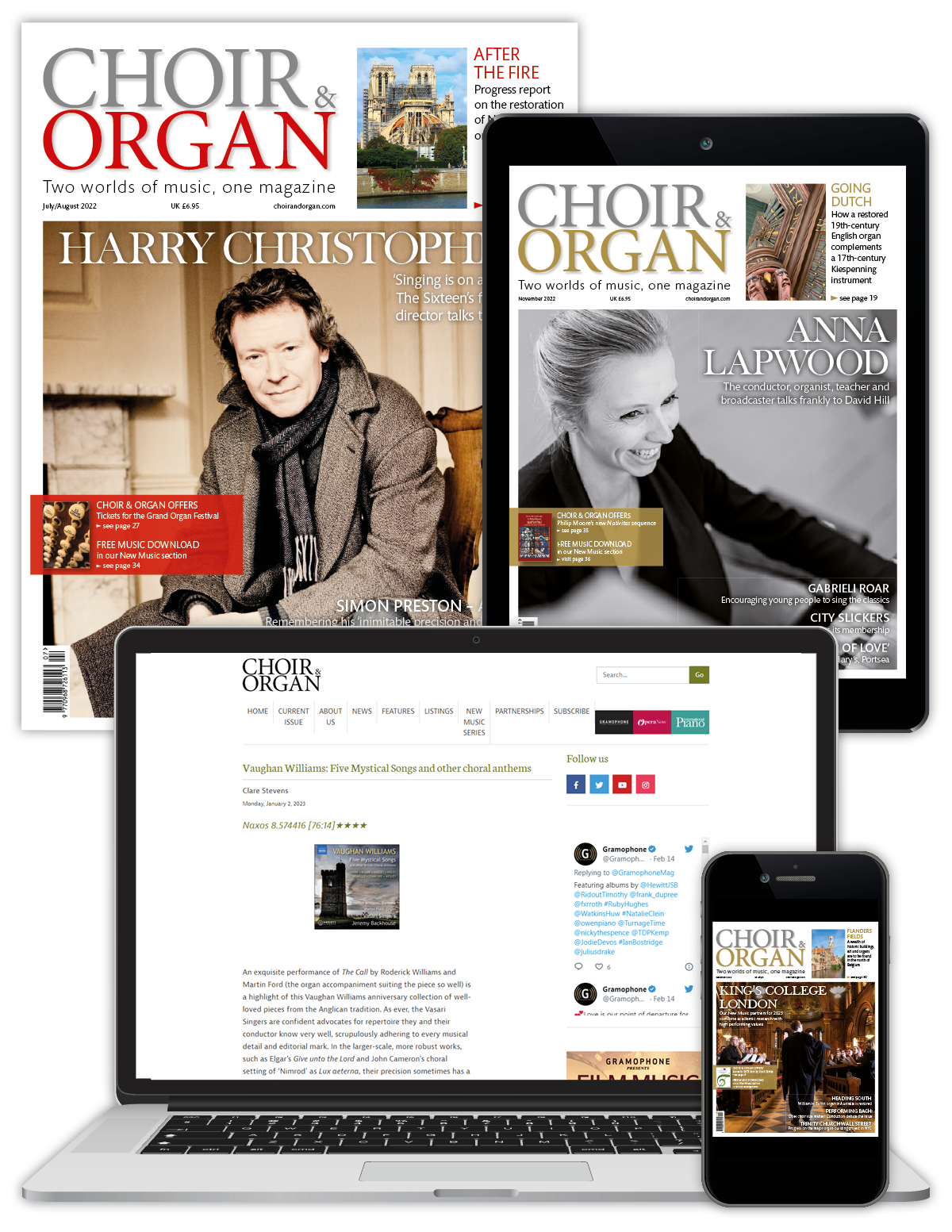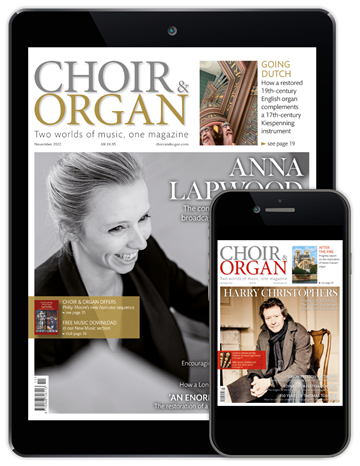Behind the scenes with John-Paul Buzard Pipe Organ Builders in Illinois
Thursday, August 29, 2024
Paul Hale visits John-Paul Buzard Pipe Organ Builders in Illinois

In April I was privileged to fly to Chicago, meet John-Paul Buzard, and spend the next few days playing his company’s organs, discussing recent and current projects, and exploring every corner of the capacious Buzard workshops and storage facility. Not least among the delights was a drive in J-P’s immaculately restored 1931 Ford Model A coupé. In the Ford we drove from the Buzards’ beautiful Urbana house to an enormous warehouse nearby in which a large and famous British organ is stored, pending restoration and installation. More on that in due course.
The instrument which set the Buzard style, in tonal architecture and console style (their Op 7, from 1991) is to be found in the Episcopal Chapel of St John the Divine in Champaign, at the heart of the University of Illinois. Buzard’s wife of 44 years, Linda, is organist & choirmaster here. The instrument dominates the west end of the chapel in a majestic but well-proportioned oak case over the west door, the choir seated on the chapel floor beneath, near the console. Buzard writes about this organ: ‘The Chapel’s solid Anglican choral programme, the rich hymnody, and daily cathedral-style liturgics demanded an organ of some substance; requiring a wide variety of tone colours at unison pitch, complete development of the various choruses, and characteristic reed stops for the English Swell, a profound Pedal, and high-volume solo effects. Although inspired by the great instrument at King’s College, Cambridge, this is not an “English organ”. The instrument exhibits classic tonal design, but is voiced with a Romantic cast.’
This was the first of the company’s organs I played; I was immediately impressed with the richness and beauty of the voicing, the notable sonority certainly having much more in common with the Anglican liturgical organ than with the more slender scales, clarity and snappy reeds of the ‘American Classic’ style which otherwise is still fairly dominant in North American organs.
Like the tonal style of this instrument, there is an element found in the new Buzard organs I encountered which takes a leaf out of the pages of the multum in parvo British organ designs espoused a century ago by such designers as Lt Col George Dixon (1870-1950) and his friend and contemporary, organbuilder Arthur Harrison (1868-1936). To increase the flexibility of what would otherwise be a two-manual organ, the Episcopal Chapel Swell is divided into two smaller expressive divisions, each on its own slider chest, and each with its own expression box and shutters. The principals, strings and chorus reeds are in Swell ‘A’, and the flutes, cornet mutations, Flute Celeste and Clarinet are in Swell ‘B’. This allows, for example, the Swell ‘A’ Oboe to be accompanied by the Swell ‘B’ Flute Celeste, or the Swell ‘B’ Clarinet to be accompanied by the Swell ‘A’ strings. The enormous increase in accompanimental flexibility which the divided Swell creates is readily controllable using general pistons.

John-Paul Buzard in the Nashville blower room
Ingenious sub-division of one section of an organ is a dominant feature of the company’s most recent large new instrument (Op 48) in St George’s Episcopal Church, Nashville, Tennessee, an organ I enjoyed playing and inspecting. In its large segmented cases, elevated either side of the sanctuary, the organ provides architectural context for the chancel and apse. Its curved façades of solid white oak in Palladian style hint at a colonnade, which the church’s architect had envisaged. There are approximately 200 façade pipes, nearly all of which speak. With preparation for an antiphonal section at the west end and with several stops awaiting installation, there are currently 56 ranks (89 stops), including an enclosed 32.16.8 Trombone/Tromba rank and a very Willis-like enclosed 16.8 Ophicleide/Tuba on heavy wind. Eventually the organ will comprise 111 stops from 73 ranks. The clever and very colourful specification can be found on the company’s website, but it is worth reproducing the stop list of the Great division [right] to illustrate the imagination which devised it. The stops in italics are enclosed and can be coupled as a complete section to all divisions. It will be seen that this secondary section has multiple tonal possibilities: a complete secondary chorus from 16ft to Sharp Mixture, a cornet décomposé, gentle choir organ-style flutes and strings, solo ranks such as the big 8ft flute, the orchestral reeds and the Trombas, and so on.
St George’s boasts a music programme well steeped in the Anglican tradition. The new organ’s sounds had to embrace the richest accompanimental demands of the Anglican liturgy and at the same time encompass both Classical and Romantic solo repertoire. John-Paul Buzard writes: ‘The heart of this, and any Buzard organ, is the Swell division. This organ’s Swell is the logical expansion of smaller Buzard organs, including three volume levels and colours of 8ft reed tone: Oboe, Cornopean and Trompette Harmonique. The battery is grounded by a lush, full-length 16ft Bassoon, to allow the Swell three distinct personalities.’
A not dissimilar (if smaller) organ is under construction for St Joseph’s Catholic Cathedral, Jefferson City, Missouri. The Swell division of this was in process of assembly in the workshop. Buzard adds: ‘Although space in the peculiarly shaped chamber area was quite limited, we challenged our chief engineer Shane Rhoades to design the space to house a modest three-manual scheme: Great, both enclosed and unenclosed, and a full Swell on an upper level, with a small “choral division” on the lower level, right behind the singers.’ The very flexible specification is a good example of the firm’s tonal outlook and displays how a modest number of ranks can be pressed into multiple uses by judicious unification and borrowing. Like many US firms, Buzard makes use of the very effective digital 32ft/16ft stops made by Walker Technical; four are to be found in this organ (and four 32ft flues in the Nashville organ). I was particularly interested, in touring the workshops (and within the St George’s organ), to see a number of Haskelled reeds. Haskelled flue basses are common enough in the UK, but there is scarcely an example of a Haskelled reed. I can report that they are highly effective, offering a better quality of tone for a reed bass than a half-length resonator does – though doubtless at a price.

The London City Temple organ destined for Chicago, Dave Brown amid the Pedal Opens
At the start of this article I mentioned a large British organ stored by the Buzard firm. This is none other than the 72-stop J W Walker organ made for the City Temple (London) in 1958, to the designs of City Temple director of music, Dr Eric Thiman. This was recently sold to St James Cathedral, Chicago, for restoration and installation. John Smagner, chair of the cathedral organ committee writes: ‘After a period of discernment, the committee concluded the Walker organ is the ideal musical instrument for St James Cathedral. We determined the organ’s size, action and wide tonal range will fulfil the requirements of the cathedral’s various musical programmes and offerings. The Walker organ will be capable of leading congregational singing during Anglican worship services, and will provide a sturdy support for soloists, the children’s choir and the adult choir. The organ’s complete stop list, with as many as 70 colourful foundations, flutes, strings, reeds and mixtures distributed across three manuals, will create a marvellous instrument for future solo recitals and concert performances.’
It was with considerable excitement that I looked at the whole City Temple organ (complete with two 32fts) – really solidly and beautifully made – carefully stored by Buzard. Not a slider chest in sight: most ranks stand on the multiple Roosevelt chests with ventil stop action which Walker routinely made at that time. I also visited St James Cathedral to see the lofty space in which the Walker organ will be set up, behind the existing organ façade, as the City Temple had no organ case, the instrument being hidden behind grilles and tall slats.
It was a delight to see that the Buzard firm is showing utter dedication to doing a perfect job, restoring even the 1958 chest-magnets, relays and switchgear.
Such dedication is evident in all their work, and one feels sure that the company will continue to flourish when settled in its new premises.
Paul Hale has written extensively about organs while also working as a cathedral organist, teacher and organ consultant
This article originally appeared in the Autumn 2024 issue of Choir & Organ. Never miss an issue – subscribe today






